When you save your presentation to OneDrive or SharePoint Online for Microsoft 365, you can collaborate on a presentation at the same time with your colleagues.
In order to work on a presentation at the same time, all authors need to be using PowerPoint 2010 or later (on Windows), PowerPoint 2016 for Mac or later, or PowerPoint for the web.
Share your presentation with others and collaborate on it at the same time
-
Open your PowerPoint presentation, and choose Share
 in the top-right corner of the ribbon when you're ready to collaborate.
in the top-right corner of the ribbon when you're ready to collaborate.If you haven't saved your presentation to OneDrive or SharePoint Online for Microsoft 365, PowerPoint prompts you to do so now. After you do that, the email invitation will be sent.

Note: If you don't want to upload your presentation to the cloud, you can share it by using the Attach a copy... options at the bottom of the dialog box.
-
In the Send Link box, enter the email address of the person you'd like to share the presentation with. If you already have the person's contact info stored, you can just enter the name. The drop-down list lets you determine whether your invitees can edit the file or only can view the file.
-
Click Share. If your file has already been saved to the cloud, an email invitation will be sent to your invitees.
See where others are working in your shared presentation
-
Open the presentation and start working in it.
If someone else is viewing or working in the presentation, their thumbnail picture appears in the top-right corner of the ribbon. PowerPoint alerts you when people enter or leave your presentation.
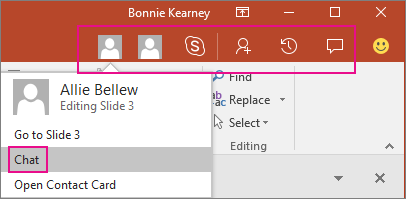
-
You'll also see the name of anyone viewing or editing the presentation in the Share pane. There's an indicator—on the thumbnail of the slide and in the actual slide—that shows where someone is working in the presentation. Hover over or select that indicator to find out who is editing.
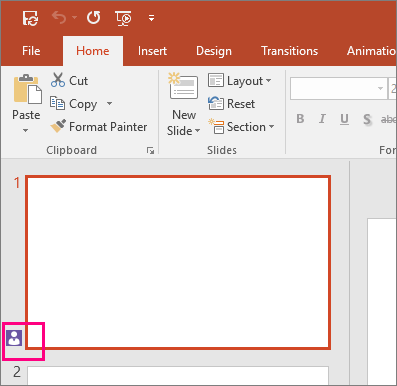
(For accessibility, PowerPoint also allows you to turn on automatic display of the editor's name. Turn it on by doing File > Options > Advanced > Display > Show presence flags for selected items.)
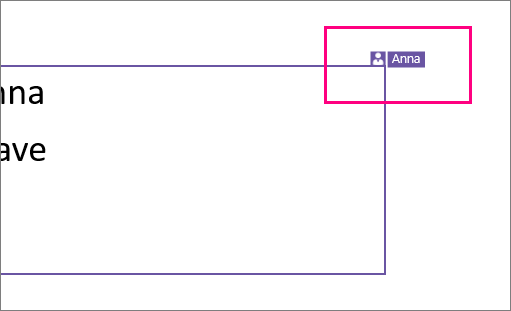
-
When you're done working, save your file.
When other authors have made changes, you'll see the following when you save.
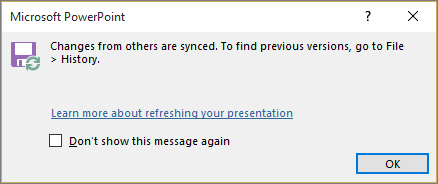
If your updates and other authors' updates don't conflict, they'll be merged automatically, and you don't need to do anything else.
Notifications when you open a changed file
| |
After other people make changes to a shared presentation file, PowerPoint for Microsoft 365 notifies you when you re-open the file. A small banner tells you who has made changes to your presentation while you were away.

Tracking changes: Revisions by others are highlighted
PowerPoint for Microsoft 365 automatically keeps track of changes made in online documents.
| |

-
When you re-open a changed presentation (or are in a file being actively edited by someone else), changed slides are highlighted in turquoise in the thumbnail pane. A tooltip says, "Slide has unread changes."
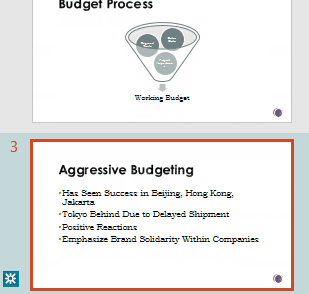
-
Select a thumbnail to look at the full-size slide. You'll see the changed portion of the slide outlined in turquoise. An accompanying notation tells you who made the change, and when. By looking at the revised slide, you clear away the turquoise highlighting and the "slide has unread changes" notation on that slide.
(There are some cases where a revised slide is highlighted, but the kind of change that has been made isn't outlined on the individual slide. Examples of such changes include: Changes in the Notes pane, deletion of a shape, addition of a comment, and animation changes.)
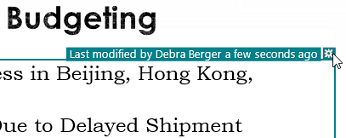
What determines whether changes are highlighted:
-
This feature works on shared documents stored in OneDrive and SharePoint.
-
Changes are highlighted only when the person who makes the change is using PowerPoint for the web, or PowerPoint for Microsoft 365—at least version 1707 of Current Channel or version 1803 of Semi-Annual Enterprise Channel. Find your Office version
-
Changes aren't highlighted if revision data has been turned off for the document in the Trust Center Privacy Options:
If the privacy options aren't turned on, a user's name (and the time when she or he last made edits to an object) are stored in the presentation to support this revision-highlighting feature. Use Document Inspector to remove that info, if necessary. (See the article Remove hidden data and personal information by inspecting documents, presentations, or workbooks for guidance on using Document Inspector.)
If the privacy options are turned on, then this revision highlighting feature is turned off, meaning that no personal data (user names and times mentioned above) is stored.
To make revision highlighting possible, data about the read/unread status of individual slides is stored separately by PowerPoint. Where that data is stored depends on which version and channel of PowerPoint you are using. We're shifting towards storing it in an online Microsoft service designed to save user settings, but we haven't entirely completed the shift yet.
The following table lists each relevant version of PowerPoint and where it stores the read/unread status data about each person who opens the file:
For this version number (or later)
The status data is stored in
PowerPoint for Microsoft 365 in Current Channel
between 1707 and 1710
On PC disk, under the path:
%appdata%\Microsoft\PowerPoint\SlideViewState
This location is protected by the Windows Users folder; if you want to, you can manually delete the files that record your own read/unread status.
PowerPoint for Microsoft 365 in Current Channel
1711
Microsoft Online service
PowerPoint for Microsoft 365 in Semi-Annual Enterprise Channel
1803
Microsoft Online service
PowerPoint for Microsoft 365 for Mac
16.11
Microsoft Online service
PowerPoint for Android
16.0.9001.2077
Microsoft Online service
PowerPoint for iOS
2.9.108.0
Microsoft Online service
PowerPoint Mobile
17.8827
Microsoft Online service
-
Changes aren't highlighted if the file is encrypted or password-protected.
-
Changes aren't highlighted if the file is in .odp format or the older PowerPoint .ppt or .pps format.
Communicate with Chat or Comments
Choose Comments  to make or view comments. Also, you can reply to or resolve comments and then mark them as complete. See Add comments for more information.
to make or view comments. Also, you can reply to or resolve comments and then mark them as complete. See Add comments for more information.
(Microsoft 365 only) You can instantly chat with other people who are working in a presentation stored on OneDrive for work or school or SharePoint in Microsoft 365. Choose the Chat button  to start a group chat with everyone working in the document.
to start a group chat with everyone working in the document.

-
The chat history isn't preserved, so if you close the document and reopen it later, you'll be starting fresh with an empty chat. If you need more persistent discussion, consider using Comments instead.
-
If another person opens the file to edit it, they can join the chat, too, but they won't see any history of the chat from before they opened the file. They'll only see new messages as of the time they opened it.
See previous versions of the file
| |
Office preserves prior versions of your SharePoint, OneDrive, and OneDrive for work or school files while you're working on them.
To open the list of the prior versions of a file, select the file name in the title bar of the app window, then select Version History.
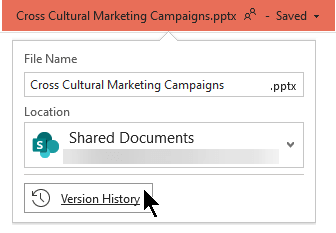
Version History is for viewing, not editing. You can see any prior version of a file.
To open a prior version:
-
In the Version History pane on the right, select Open version in one of the version-history items.
A read-only copy of that version is opened in a separate PowerPoint window.
Resolve conflicting changes
If there are conflicting changes, a visual comparison between your changes and the conflicting changes from one of your collaborators will pop up when you select Save. You can choose the changes you'd like to keep.
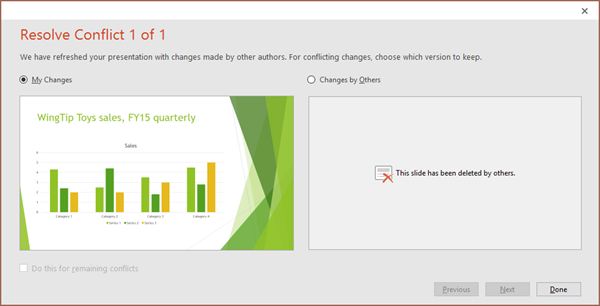
Only changes made by others that directly conflict with changes you've made will show up in the comparison. Non-conflicting changes are merged automatically into your presentation when you save, and you'll see them in the My Changes view.
-
Choose either My Changes or Changes by Others.
-
If there is more than one conflict to resolve, do one of the following:
-
Choose Next to keep resolving conflicts. Choose Previous to revisit an earlier conflict.
-
If you'd like to choose the same set of changes for all the remaining conflicts, select the Do this for remaining conflicts check box.
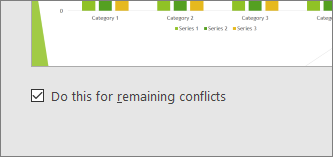
-
-
When you're done resolving conflicts, choose Done.
Do you miss Slide Libraries?
Go to the PowerPoint Suggestion Box and vote for reviving this feature.
Share a presentation and co-author
-
Create a draft of the presentation, and then save it to a shared location, such as OneDrive or SharePoint.
-
Open and start working on the presentation.
Note: If someone else is working on the presentation, you'll see a Co-authoring icon
 and a number in the status bar that tell you how many people are working on the presentation. Click the Co-authoring icon
and a number in the status bar that tell you how many people are working on the presentation. Click the Co-authoring icon  to see who is working on the presentation (as shown below).
to see who is working on the presentation (as shown below).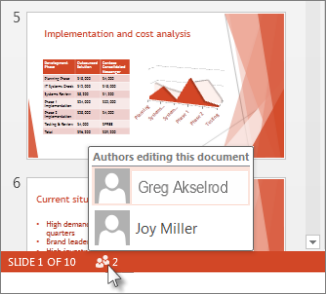
-
When you're done working, click File > Save.
If you're the only one working on the presentation, the file will save and you're done. If your updates and other authors' updates do not conflict, they will merge automatically, and you don't need to do anything else.
Resolve changes made by other people
If others are working on the same presentation, you many encounter one of the following error messages:
-
When other authors have made changes, you'll see the following:

-
If the changes you and other authors have made conflict with one another, this message appears:

Here's how to resolve changes made by other people:
-
On the Merge tab, click Show Changes, and then do one of the following:
-
To view only conflicting updates, click Show Only Conflicts.
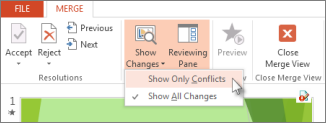
-
To view all changes, click Show All Changes.
-
-
To accept or reject changes, do one or both of the following:
For conflicting changes:
-
To accept a conflicting change, check the box next to the conflicting change icon
 (shown below).
(shown below).
-
To reject a conflicting change, do nothing. Boxes that aren't checked won't be added to the presentation.
For standard changes:
-
To accept a standard change, do nothing.

-
To reject a standard change, clear the box.
-
-
When you're done reviewing changes, select Close Merge View.
After you select Close Merge View, all changes will be applied and uploaded to the server.
Note: After you select Close Merge View, you can't go back and view flagged changes.
Co-author a presentation
-
In PowerPoint 2010, open the presentation that is stored on the server.
A notification appears in the status bar at the bottom of PowerPoint if you're not the only one working on the presentation. The notification tells you how many people are currently working on the presentation. Click that number to see the names of the co-authors.
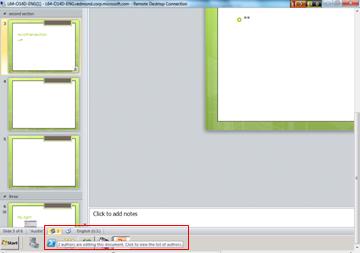
-
On the View tab, in the Presentation Views group, click Normal to view your presentation in Normal view.
-
In the left pane that contains the Outline and Slides tabs, on the Slides tab, look for a small icon on the lower-right corner of the slide thumbnail. That indicates that a co-author is making changes to that slide. Click the icon to see the name of the co-author.
Notes:
-
Another way to see the names of the co-authors of the presentation is to click the File tab, and then click Info on the left side of the screen. The names of the co-authors appear in the middle pane.
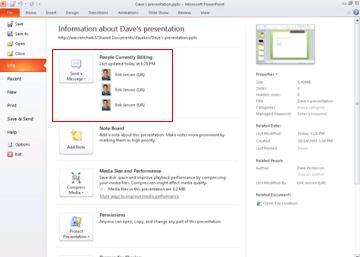
-
To send an e-mail message or instant message to your co-authors, click Send a Message, and then click Send an E-mail Message or Send an Instant Message.
-
When another author saves their changes, PowerPoint notifies you, the original author of the presentation, that changes were made. On the pane that contains the Outline and Slides tabs, on the Slides tab, an icon appears in the lower-right corner of the slide thumbnail that was changed.
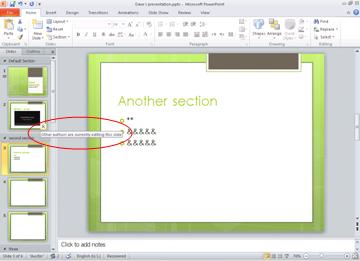
-
Review changes that were made by other authors
-
To see whether other authors have changed your presentation, click the File tab and then click Info. Then, next to Document Updates Available, click Save, and then click Save and Review.

-
Then, to see the changes that other authors made, click Review Changes.

-
When you click Review Changes, the Merge tab appears on the ribbon and a Revisions pane appears on the right side of the PowerPoint window. The Revisions pane contains a Slides tab that lists the slides that other authors changed, and a Details tab that lists the changes to the currently displayed slide.
On the Merge tab, you can use the buttons in the Resolutions group to show next and previous changes that were made by other authors, and accept or reject those changes. To exit Merge view, click Close Merge View.
Note: While in Merge view, you cannot merge in new updates from other authors or upload changes to the server. You must complete your review by clicking Close Merge View, which then automatically uploads your changes to the server.
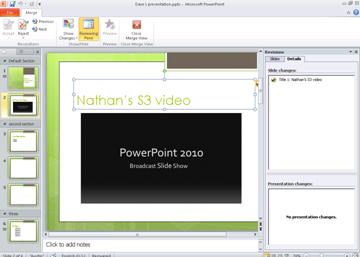
Configure PowerPoint to notify you every time authors make changes
You might want to review (and then accept or reject) changes that other authors make to all presentations that you work on, before they're merged. If so, do this:
-
Click the File tab.
-
Click Options on the left side of the screen, and then in the PowerPoint Options dialog box, click Save.
-
Under File merge options for shared document collaboration server files, select the Show detailed merge changes when a merge occurs check box.
Share your presentation with others and collaborate on it at the same time
-
Open your PowerPoint presentation, and at the top-right corner of the ribbon, select Share
 and then select Invite People.
and then select Invite People.
If you haven't saved your presentation to OneDrive or SharePoint Online for Microsoft 365, PowerPoint prompts you to do so now.
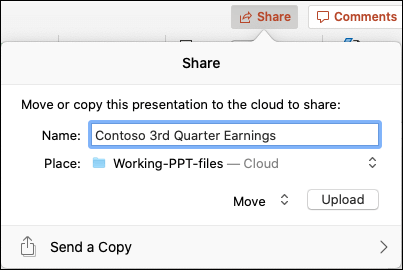
Note: If you'd rather not upload your presentation to your OneDrive or SharePoint, you can share it via an email attachment by selecting Send a Copy instead.
-
Enter the email address of the person you'd like to share the presentation with. If you already have the person's contact info stored, you can just enter the name. The control at the top lets you determine whether your invitees can edit the file or only can view the file.
-
Click Share. An email will be sent to your invitees.
See where others are working in your shared presentation
-
Open the presentation and start working in it.
If someone else is viewing or working in the presentation, their thumbnail picture appears in the top-right corner of the ribbon. PowerPoint alerts you when people enter or leave your presentation.

-
You'll also see the name of anyone viewing or editing the presentation in the Share pane. There's an indicator—on the thumbnail of the slide and in the actual slide—that shows where someone is working in the presentation. Hover over or select that indicator to find out who is editing.

(For accessibility, PowerPoint also allows you to turn on automatic display of the editor's name. Turn it on by selecting PowerPoint > Preferences > View > Show presence flags for selected items.)

-
When you're done working, save your file.
If your updates and other authors' updates don't conflict, they'll be merged automatically, and you don't need to do anything else.
Notifications when you open a changed file
| |
After other people make changes to a shared presentation file, PowerPoint for Microsoft 365 for Mac notifies you when you re-open the file. A small banner tells you who has made changes to your presentation while you were away.

Tracking changes: Revisions by others are highlighted
| |
PowerPoint for Microsoft 365 for Mac automatically keeps track of changes made in online documents.
| |

-
When you re-open a changed presentation (or are in a file being actively edited by someone else), changed slides are highlighted in turquoise in the thumbnail pane. A tooltip says, "Slide has unread changes."

-
Select a thumbnail to look at the full-size slide. You'll see the changed portion of the slide outlined in turquoise. An accompanying notation tells you who made the change, and when. By looking at the revised slide, you clear away the turquoise highlighting and the "slide has unread changes" notation on that slide.
(There are some cases where a revised slide is highlighted, but the kind of change that has been made isn't outlined on the individual slide. Examples of such changes include: Changes in the Notes pane, deletion of a shape, addition of a comment, and animation changes.)

What determines whether changes are highlighted:
-
This feature works on shared documents stored in OneDrive and SharePoint.
-
Changes are highlighted only when the person who makes the change is using PowerPoint for the web, or PowerPoint for Microsoft 365 for Mac—at least version 16.11. Find your Office version
-
Changes aren't highlighted if the file is encrypted or password-protected.
-
Changes aren't highlighted if the file is in .odp format or the older PowerPoint .ppt or .pps format.
Communicate by using Comments
At the right end of the toolbar ribbon, select Comments  to see all comments currently in the presentation.
to see all comments currently in the presentation.
You can add a new comment or reply to or resolve existing comments.
(Microsoft 365 only) Tag a colleague in a comment by using the @-sign followed by the person's name. That person receives an email message with a link to your comment. Clicking the link brings them into the document and into the conversation.
(Microsoft 365 only) You can Chat with someone who's editing the file at the same time as you. To get started, click the chat icon  near the top right of the screen.
near the top right of the screen.

See previous versions of the file
| |
Office preserves prior versions of your SharePoint, OneDrive, and OneDrive for work or school files while you're working on them.
To open the list of the prior versions of a file, select the file name in the title bar of the app window, then select Browse Version History.
Version History is for viewing, not editing. You can see any prior version of a file.
To open a prior version:
-
In the Version History pane on the right, select Open Version in one of the version-history items.
A read-only copy of that version is opened in a separate PowerPoint window.
You can copy content from a prior version. You can also Save A Copy of a prior version so that you can edit it separately from the file you're currently working on.
Share a presentation with others
-
At the right end of the toolbar ribbon, click Share

-
In the Send Link dialog box, enter the names or email addresses of the folks you want to share the presentation with.
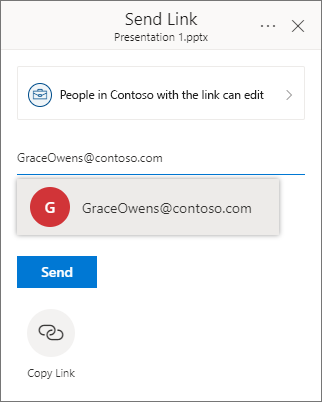
Add a message to your colleagues if you like.
-
Click Send.
See where others are working in your shared presentation
When multiple people work in a file at the same time, indicators show you where they are:
-
Towards the top right corner of the window you'll see a badge - with their profile picture or initials - for each person who currently has the file open. Select that badge to see where in the slide deck they currently are.
-
On the thumbnail pane you'll see a label appear at the top right corner of the slide thumbnail with the name of the person currently on that slide.
See revisions made by other people
When you open a presentation that someone else has changed, PowerPoint tells you in two ways:
-
A While You Were Away message appears on the right side of the window.

-
In the slide thumbnail pane on the left, slides that have been revised are highlighted with a turquoise background.

When you open that slide, you'll also see a turquoise outline around the revised slide element. By looking at the revised slide, you clear away the turquoise highlighting and the "slide has unread changes" notation on that slide.
Confer by using Comments or Chat
At the right end of the toolbar ribbon, select Comments  to see all comments currently in the presentation.
to see all comments currently in the presentation.
You can add a new comment or reply to or resolve existing comments.
Tag a colleague in a comment by using the @-sign followed by the person's name. That person receives an email message with a link to your comment. Clicking the link brings them into the document and into the conversation.
You can Chat with someone who's editing the file at the same time as you. To get started, click the chat button  near the top right of the screen.
near the top right of the screen.

See previous versions of the file
Office preserves prior versions of your SharePoint, OneDrive, and OneDrive for work or school files while you're working on them.
Use File > Info > Version History to open the list of the prior versions of a file.
Version History is for viewing, not editing. You can see any prior version of a file. You can copy content from a prior version. You can also Save A Copy of a prior version so that you can edit it separately from the file you're currently working on.
Rename a presentation file
You can rename a file in PowerPoint for the web while you're co-authoring with others.
-
Click the file name in the center of the title bar of PowerPoint for the web near the top of the browser window.
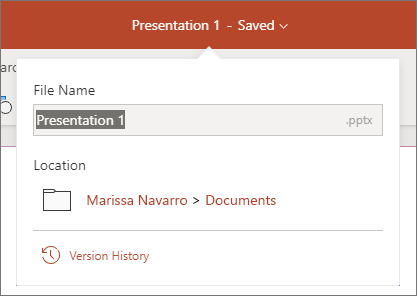
-
Type a new name for the file. Or use the arrow keys to position the insertion point within the title, and then type your changes to the file name.
-
Press Enter when you're done.
In a moment, the name change syncs with other instances of the file that are currently open.
 This feature is available only to
This feature is available only to
No comments:
Post a Comment